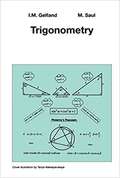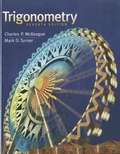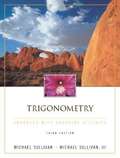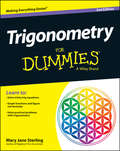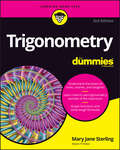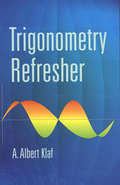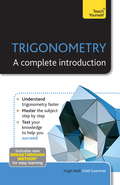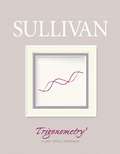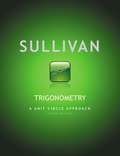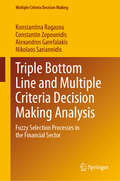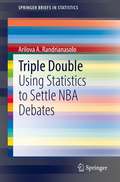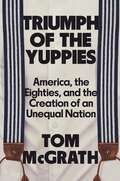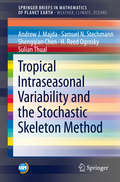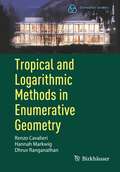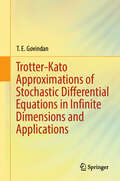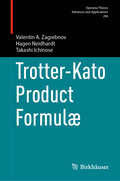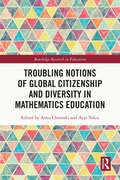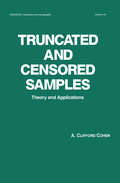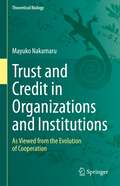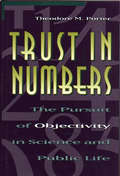- Table View
- List View
Trigonometry (Gelfand School Outreach Program)
by I. M. Gelfand Mark SaulIn a sense, trigonometry sits at the center of high school mathematics. <p><p> It originates in the study of geometry when we investigate the ratios of sides in similar right triangles, or when we look at the relationship between a chord of a circle and its arc. It leads to a much deeper study of periodic functions, and of the so-called transcendental functions, which cannot be described using finite algebraic processes. It also has many applications to physics, astronomy, and other branches of science. It is a very old subject. Many of the geometric results that we now state in trigonometric terms were given a purely geometric exposition by Euclid. Ptolemy, an early astronomer, began to go beyond Euclid, using the geometry of the time to construct what we now call tables of values of trigonometric functions. <p><p> Trigonometry is an important introduction to calculus, where one studies what mathematicians call analytic properties of functions. One of the goals of this book is to prepare you for a course in calculus by directing your attention away from particular values of a function to a study of the function as an object in itself. This way of thinking is useful not just in calculus, but in many mathematical situations. So trigonometry is a part of pre-calculus, and is related to other pre-calculus topics, such as exponential and logarithmic functions, and complex numbers.
Trigonometry (Seventh Edition)
by Charles P. Mckeague Mark D. TurnerGain a solid understanding of the principles of trigonometry and how these concepts apply to real life with McKeague/Turner's TRIGONOMETRY. This book's proven approach presents contemporary concepts in brief, manageable sections using current, detailed examples and interesting applications. Captivating illustrations drawn from Lance Armstrong's cycling success, the Ferris wheel, and even the human cannonball show trigonometry in action. Unique Historical Vignettes offer a fascinating glimpse at how many of the central ideas in trigonometry began.
Trigonometry Enhanced with Graphing Utilities (3rd Edition)
by Michael Sullivan"The Sullivan Enhanced with Graphing Utilities" series fully integrates the graphing calculator. These widely adopted books are known for their precise careful presentation of mathematics. This precision permeates the book and is particularly evident in the examples, pedagogy and exercises. This book includes coverage of trigonometric functions and their applications, analytic trigonometry, polar coordinates and vectors, and exponential and logarithmic functions. For anyone who needs to brush up on everyday or business-related mathematics.
Trigonometry For Dummies
by Mary Jane SterlingA plain-English guide to the basics of trigTrigonometry deals with the relationship between the sides and angles of triangles... mostly right triangles. In practical use, trigonometry is a friend to astronomers who use triangulation to measure the distance between stars. Trig also has applications in fields as broad as financial analysis, music theory, biology, medical imaging, cryptology, game development, and seismology.From sines and cosines to logarithms, conic sections, and polynomials, this friendly guide takes the torture out of trigonometry, explaining basic concepts in plain English and offering lots of easy-to-grasp example problems. It also explains the "why" of trigonometry, using real-world examples that illustrate the value of trigonometry in a variety of careers.Tracks to a typical Trigonometry course at the high school or college levelPacked with example trig problemsFrom the author of Trigonometry Workbook For DummiesTrigonometry For Dummies is for any student who needs an introduction to, or better understanding of, high-school to college-level trigonometry.
Trigonometry For Dummies
by Mary Jane SterlingMake trigonometry as easy as 1-2-3 Believe it or not, trigonometry is easier than it looks! With the right help, you can breeze through your next trig class, test, or exam and be ready for your next math challenge. In Trigonometry For Dummies, you’ll learn to understand the basics of sines, cosines, and tangents, graph functions, solve tough formulas, and even discover how to use trig outside the classroom in some cool and interesting ways. Ditch the confusing jargon and take a plain-English tour of one of the most useful disciplines in math. In this lifesaving guide, you’ll learn how to: Graph trig functions, including sine, cosine, tangent, and cotangent functions Understand inverse trig functions and solve trig equations Relate triangles to circular functions and get a handle on basic identitiesSo, whether you’re looking for an easy-to-use study guide, to boost your math grade, or get a refresher on some basic trig concepts after a long absence from studying, Trigonometry For Dummies is your ticket to understanding the mathematical mysteries of the triangle.
Trigonometry Refresher (Dover Books On Mathematics Ser.)
by A. Albert KlafThis classic text encompasses the most important aspects of plane and spherical trigonometry in a question-and-answer format. Its 913 specially selected questions appear with detailed answers that help readers refresh their trigonometry skills or clear up difficulties in particular areas. Questions and answers in the first part discuss plane trigonometry, proceeding to examinations of special problems in navigation, surveying, elasticity, architecture, and various fields of engineering. The final section explores spherical trigonometry and the solution of spherical triangles, with applications to terrestrial and astronomical problems. Readers can test their progress with 1,738 problems, many of which feature solutions. 1946 edition. 494 figures.
Trigonometry: A Complete Introduction
by Hugh NeillTrigonometry: A Complete Introduction is the most comprehensive yet easy-to-use introduction to Trigonometry. Written by a leading expert, this book will help you if you are studying for an important exam or essay, or if you simply want to improve your knowledge. The book covers all areas of trigonometry including the theory and equations of tangent, sine and cosine, using trigonometry in three dimensions and for angles of any magnitude, and applications of trigonometry including radians, ratio, compound angles and circles related to triangles. Everything you will need is here in this one book. Each chapter includes not only an explanation of the knowledge and skills you need, but also worked examples and test questions.
Trigonometry: A Unit Circle Approach (8th Edition)
by Michael SullivanThis textbook helps students build the knowledge and skills they need to be successful in trigonometry. It contains a number of theorems, definitions, procedures, and equations. The lessons include Graphs and Functions, Trigonometric Functions, Analytic Trigonometry, Applications of Trigonometric Functions, Polar Coordinates Vectors, Analytic Geometry, Exponential and Logarithmic Functions, etc.
Trigonometry: A Unit Circle Approach (9th Edition)
by Michael SullivanMike Sullivan’s time-tested approach focuses students on the fundamental skills they need for the course: preparing for class, practicing with homework, and reviewing the concepts. In the Ninth Edition, Trigonometry: A Unit Circle Approach has evolved to meet today’s course needs, building on these hallmarks by integrating projects and other interactive learning tools for use in the classroom or online.
Trigonometry: Teach Yourself
by Hugh NeillTrigonometry: A Complete Introduction is the most comprehensive yet easy-to-use introduction to Trigonometry. Written by a leading expert, this book will help you if you are studying for an important exam or essay, or if you simply want to improve your knowledge. The book covers all areas of trigonometry including the theory and equations of tangent, sine and cosine, using trigonometry in three dimensions and for angles of any magnitude, and applications of trigonometry including radians, ratio, compound angles and circles related to triangles. Everything you will need is here in this one book. Each chapter includes not only an explanation of the knowledge and skills you need, but also worked examples and test questions.
Trigonometry: The Easy Way to Learn Trig
by Hugh NeillTrigonometry: A Complete Introduction is the most comprehensive yet easy-to-use introduction to Trigonometry. Written by a leading expert, this book will help you if you are studying for an important exam or essay, or if you simply want to improve your knowledge. The book covers all areas of trigonometry including the theory and equations of tangent, sine and cosine, using trigonometry in three dimensions and for angles of any magnitude, and applications of trigonometry including radians, ratio, compound angles and circles related to triangles. Everything you will need is here in this one book. Each chapter includes not only an explanation of the knowledge and skills you need, but also worked examples and test questions.
Triple Bottom Line and Multiple Criteria Decision Making Analysis: Fuzzy Selection Processes in the Financial Sector (Multiple Criteria Decision Making)
by Constantin Zopounidis Konstantina Ragazou Alexandros Garefalakis Nikolaos SariannidisThis book offers a comprehensive compilation of research on the evaluation of the most environmentally and socially responsible financial institutions using a multiple criteria decision-making (MCDM) approach, with a focus on the principles of the Triple Bottom Line (TBL) model. Contributed by highly esteemed scholars in the field of MCDM/A, the book serves as a distinctive global reference guide that focuses on the examination, quantification, and administration of sustainability in relation to the TBL within a multidimensional framework for decision analysis. It presents the implementation of a set of MCDA techniques addressing challenges in the accounting systems of financial institutions and facilitating the identification of the optimal sustainable option within this domain. It highlights recent advancements in decision-making methodologies, exemplified through practical applications in the financial industry, particularly focusing on sustainability-related subjects. As such, scholars and policymakers will find this book to be a valuable resource.
Triple Double: Using Statistics to Settle NBA Debates (SpringerBriefs in Statistics)
by Arilova A. RandrianasoloThis book provides empirical evidence and statistical analyses to uncover answers to some of the most debated questions in the NBA. The sports world lives and breathes off of debates on who deserves an MVP award, and which athletes should be considered all-stars. This book provides some statistics-backed perspectives to some of these debates that are specific to the NBA. Was LeBron snubbed of an MVP in the 2010-2011 season? Why has the G.O.A.T. debate turned into LeBron vs. Jordan….Did Kobe get overlooked? How come Klay Thompson didn’t get All-NBA honors in the 2018-2019 season? This book explores these questions and many more with empirical evidence. This book is invaluable for any undergraduate or masters level course in sport analytics, sports marketing, or sports management. It will also be incredibly useful for scouts, recruiters, and general managers in the NBA who would like to use analytics in their work.
Triumph of the Yuppies: America, the Eighties, and the Creation of an Unequal Nation
by Tom McGrathThe &“entertaining and insightful&” first history of the Yuppie phenomenon, chronicling the roots, rise, triumph and (seeming) fall of the young urban professionals who radically altered American life between 1980 and 1987 (New York Times bestselling author Ben Mezrich). By the time their obituary was being written in the late 1980s, Yuppies—the elite, uber‑educated faction of the Baby Boom generation—had become a cultural punchline. But amidst the Yuppies' preoccupation with money, work, and the latest status symbols, something serious was happening, too, something that continues to have profound ramifications on American culture four decades later. Brimming with lively and nostalgic details (think Jane Fonda, The Sharper Image, and over-the-top fashion), Triumph of the Yuppies charts Boomers' transformation from hippy idealists in the late 1960s to careerists in the early 1980s, and details how marketers, the media, and politicians pivoted to appeal to this influential new group. Yuppie values had an undeniable impact on the worlds of fashion, food, and fitness, as well as affecting the broader culture—from gentrification and an obsession with career success to an indulgent materialism. Most significantly, the me‑first mindset typical of Yuppieness helped create the largest income inequality in a century. Tom McGrath&’s masterful cultural history reveals how Yuppies reshaped American society. It is a portrait of America just as it was beginning to come apart—and the origin story of the fractured country we live in today.
Trivalent Discrete Surfaces and Carbon Structures (SpringerBriefs in the Mathematics of Materials #5)
by Hisashi NaitoThis book discusses discrete geometric analysis, especially topological crystallography and discrete surface theory for trivalent discrete surfaces. Topological crystallography, based on graph theory, provides the most symmetric structure among given combinatorial structures by using the variational principle, and it can reproduce crystal structures existing in nature. In this regard, the topological crystallography founded by Kotani and Sunada is explained by using many examples. Carbon structures such as fullerenes are considered as trivalent discrete surfaces from the viewpoint of discrete geometric analysis. Discrete surface theories usually have been considered discretization of smooth surfaces. Here, consideration is given to discrete surfaces modeled by crystal/molecular structures, which are essentially discrete objects.
Tropical Circuit Complexity: Limits of Pure Dynamic Programming (SpringerBriefs in Mathematics)
by Stasys JuknaThis book presents an enticing introduction to tropical circuits and their use as a rigorous mathematical model for dynamic programming (DP), which is one of the most fundamental algorithmic paradigms for solving combinatorial, discrete optimization problems. In DP, an optimization problem is broken up into smaller subproblems that are solved recursively. Many classical DP algorithms are pure in that they only use the basic (min,+) or (max,+) operations in their recursion equations. In tropical circuits, these operations are used as gates. Thanks to the rigorous combinatorial nature of tropical circuits, elements from the Boolean and arithmetic circuit complexity can be used to obtain lower bounds for tropical circuits, which play a crucial role in understanding the limitations and capabilities of these computational models. This book aims to offer a toolbox for proving lower bounds on the size of tropical circuits.In this work, the reader will find lower-bound ideas and methods that have emerged in the last few years, with detailed proofs. Largely self-contained, this book is meant to be approachable by graduate students in mathematics and computer science with a special interest in circuit complexity.
Tropical Intraseasonal Variability and the Stochastic Skeleton Method (Mathematics of Planet Earth)
by Andrew J. Majda Samuel N. Stechmann Shengqian Chen H. Reed Ogrosky Sulian ThualIn this text, modern applied mathematics and physical insight are used to construct the simplest and first nonlinear dynamical model for the Madden-Julian oscillation (MJO), i.e. the stochastic skeleton model. This model captures the fundamental features of the MJO and offers a theoretical prediction of its structure, leading to new detailed methods to identify it in observational data. The text contributes to understanding and predicting intraseasonal variability, which remains a challenging task in contemporary climate, atmospheric, and oceanic science. In the tropics, the Madden-Julian oscillation (MJO) is the dominant component of intraseasonal variability. One of the strengths of this text is demonstrating how a blend of modern applied mathematical tools, including linear and nonlinear partial differential equations (PDEs), simple stochastic modeling, and numerical algorithms, have been used in conjunction with physical insight to create the model. These tools are also applied in developing several extensions of the model in order to capture additional features of the MJO, including its refined vertical structure and its interactions with the extratropics. This book is of interest to graduate students, postdocs, and senior researchers in pure and applied mathematics, physics, engineering, and climate, atmospheric, and oceanic science interested in turbulent dynamical systems as well as other complex systems.
Tropical and Logarithmic Methods in Enumerative Geometry (Oberwolfach Seminars #52)
by Renzo Cavalieri Hannah Markwig Dhruv RanganathanThis book is based on the lectures given at the Oberwolfach Seminar held in Fall 2021. Logarithmic Gromov-Witten theory lies at the heart of modern approaches to mirror symmetry, but also opens up a number of new directions in enumerative geometry of a more classical flavour. Tropical geometry forms the calculus through which calculations in this subject are carried out. These notes cover the foundational aspects of this tropical calculus, geometric aspects of the degeneration formula for Gromov-Witten invariants, and the practical nuances of working with and enumerating tropical curves. Readers will get an assisted entry route to the subject, focusing on examples and explicit calculations.
Trotter-Kato Approximations of Stochastic Differential Equations in Infinite Dimensions and Applications
by T. E. GovindanThis is the first comprehensive book on Trotter-Kato approximations of stochastic differential equations (SDEs) in infinite dimensions and applications. This research monograph brings together the varied literature on this topic since 1985 when such a study was initiated. The author provides a clear and systematic introduction to the theory of Trotter-Kato approximations of SDEs and also presents its applications to practical topics such as stochastic stability and stochastic optimal control. The theory assimilated here is developed slowly and methodically in digestive pieces.The book begins with a motivational chapter introducing several different models that highlight the importance of the theory on abstract SDEs that will be considered in the subsequent chapters. The author next introduces the necessary mathematical background and then leads the reader into the main discussion of the monograph, namely, the Trotter-Kato approximations of many classes of SDEs in Hilbert spaces, Trotter-Kato approximations of SDEs in UMD Banach spaces and some of their applications. Most of the results presented in the main chapters appear for the first time in a book form. The monograph also contains many illustrative examples on stochastic partial differential equations and one in finance as an application of the Trotter-Kato formula. The key steps are included in all proofs which will help the reader to get a real insight into the theory of Trotter-Kato approximations and its use. This book is intended for researchers and graduate students in mathematics specializing in probability theory. It will also be useful to numerical analysts, engineers, physicists and practitioners who are interested in applying the theory of stochastic evolution equations. Since the approach is based mainly in semigroup theory, it is accessible to a wider audience including non-specialists in stochastic processes.
Trotter-Kato Product Formulæ (Operator Theory: Advances and Applications #296)
by Valentin A. Zagrebnov Hagen Neidhardt Takashi IchinoseThe book captures a fascinating snapshot of the current state of results about the operator-norm convergent Trotter-Kato Product Formulæ on Hilbert and Banach spaces. It also includes results on the operator-norm convergent product formulæ for solution operators of the non-autonomous Cauchy problems as well as similar results on the unitary and Zeno product formulæ.After the Sophus Lie product formula for matrices was established in 1875, it was generalised to Hilbert and Banach spaces for convergence in the strong operator topology by H. Trotter (1959) and then in an extended form by T. Kato (1978). In 1993 Dzh. L. Rogava discovered that convergence of the Trotter product formula takes place in the operator-norm topology. The latter is the main subject of this book, which is dedicated essentially to the operator-norm convergent Trotter-Kato Product Formulæ on Hilbert and Banach spaces, but also to related results on the time-dependent, unitary and Zeno product formulæ. The book yields a detailed up-to-date introduction into the subject that will appeal to any reader with a basic knowledge of functional analysis and operator theory. It also provides references to the rich literature and historical remarks.
Troubling Notions of Global Citizenship and Diversity in Mathematics Education (Routledge Research in Education)
by Ayşe YolcuThis edited volume explores how mathematics education is re/configured in relation to its past, present, and future when the rhetoric of critical global citizenship education is being applied to diverse local settings.Drawing upon diverse theoretical and methodological traditions across the globe including countries in South America, Asia, Australia, and Europe, each chapter challenges and, eventually, troubles the wide circulation of a universal imagery of citizenship based on mathematical competence in not only curriculum, school reforms and policy but also in teaching and learning practices. Troubling the Euro-centric and global notions of citizenship and diversity, the book foregrounds local practices in mathematics education to portray a broader picture for the current problems of equity, social justice, and democracy. The book also engages with critical discussions on how ‘citizens’ and ‘noncitizen’ are being fabricated in the context of educational policies and specific mathematical practices.First of its kind, to trouble what is at stake when mathematics education is framed within the discourses of citizenship globally (through challenging and problematising what is understood as ‘normal’), this book will be of relevance to scholars, academics, and researchers in the field of sociology of education, anthropology of education, philosophy of education, mathematics education, citizenship studies, and international and comparative education.
Trucks and Diggers One to Ten Counting
by CaterpillarKids love trucks and diggers, and with the help of full color photographs featuring rugged Caterpillar machines, these budding little contractors will love learning counting, too!
Truncated and Censored Samples: Theory and Applications (Statistics: A Series of Textbooks and Monographs)
by A. Clifford CohenThis book deals with the development of methodology for the analysis of truncated and censored sample data. It is primarily intended as a handbook for practitioners who need simple and efficient methods for the analysis of incomplete sample data.
Trust and Credit in Organizations and Institutions: As Viewed from the Evolution of Cooperation (Theoretical Biology)
by Mayuko NakamaruThis book shows that evolutionary game theory can unravel how mutual cooperation, trust, and credit in a group emerge in organizations and institutions. Some organizations and institutions, such as insurance unions, credit unions, and banks, originated from very simple mutual-aid groups. Members in these early-stage mutual-aid groups help each other, making rules to promote cooperation, and suppressing free riders. Then, they come to “trust” not only each other but also the group they belong to, itself. The division of labor occurs when the society comes to have diversity and complexity in a larger group, and the division of labor also requires mutual cooperation and trust among different social roles. In a larger group, people cannot directly interact with each other, and the reputation of unknown people helps other decide who is a trustworthy person. However, if gossip spreads untruths about a reputation, trust and cooperation are destroyed. Therefore, how to suppress untrue gossip is also important for trust and cooperation in a larger group. If trustworthiness and credibility can be established, these groups are successfully sustainable. Some develop and evolve and then mature into larger organizations and institutions. Finally, these organizations and institutions become what they are now. Therefore, not only cooperation but also trust and credit are keys to understanding these organizations and institutions.The evolution of cooperation, a topic of research in evolutionary ecology and evolutionary game theory, can be applied to understanding how to make institutions and organizations sustainable, trustworthy, and credible. It provides us with the idea that evolutionary game theory is a good mathematical tool to analyze trust and credit. This kind of research can be applied to current hot topics such as microfinance and the sustainable use of ecosystems.
Trust in Numbers: The Pursuit of Objectivity in Science and Public Life
by Theodore M. PorterThis investigation of the overwhelming appeal of quantification in the modern world discusses the development of cultural meanings of objectivity over two centuries. How are we to account for the current prestige and power of quantitative methods? The usual answer is that quantification is seen as desirable in social and economic investigation as a result of its successes in the study of nature. Theodore Porter is not content with this. Why should the kind of success achieved in the study of stars, molecules, or cells be an attractive model for research on human societies? he asks. And, indeed, how should we understand the pervasiveness of quantification in the sciences of nature? In his view, we should look in the reverse direction: comprehending the attractions of quantification in business, government, and social research will teach us something new about its role in psychology, physics, and medicine. Drawing on a wide range of examples from the laboratory and from the worlds of accounting, insurance, cost-benefit analysis, and civil engineering, Porter shows that it is "exactly wrong" to interpret the drive for quantitative rigor as inherent somehow in the activity of science except where political and social pressures force compromise. Instead, quantification grows from attempts to develop a strategy of impersonality in response to pressures from outside. Objectivity derives its impetus from cultural contexts, quantification becoming most important where elites are weak, where private negotiation is suspect, and where trust is in short supply.
